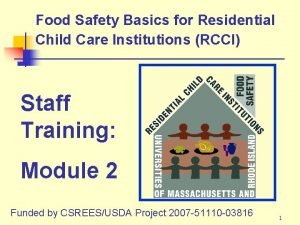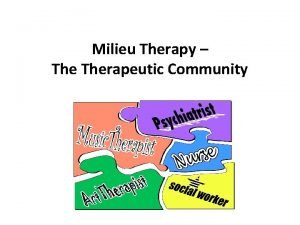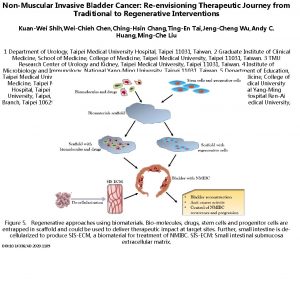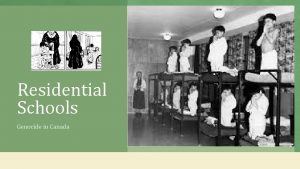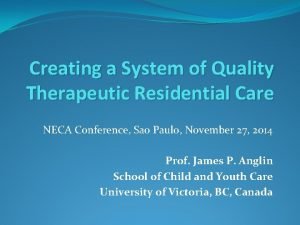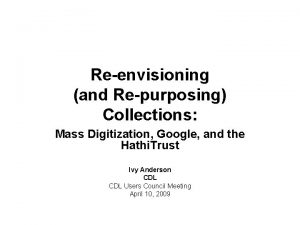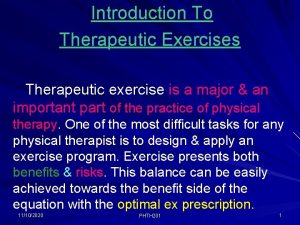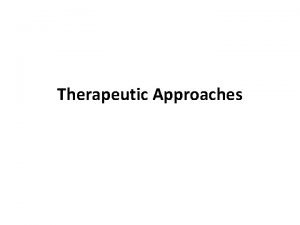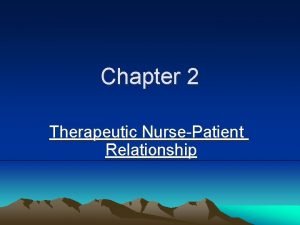ReEnvisioning Therapeutic Group and Residential Care Closing the
























- Slides: 24

Re‐Envisioning Therapeutic Group and Residential Care: Closing the Gap Between: “What We Know” and “What We Do”

Defining “Therapeutic Residential Care” ‘Therapeutic residential care’ involves the planful use of a purposefully constructed, multi‐ dimensional living environment designed to enhance or provide treatment, education, socialization, support, and protection to children and youth with identified mental health or behavioral needs in partnership with their families and in collaboration with a full spectrum of community‐ based formal and informal helping resources. (Whittaker, Del Valle, & Holmes, 2014, p. 24)

Three Types of Residential Care Campus‐‐‐Based Therapeutic Care • The goal of campus‐‐‐based therapeutic care is to return the young person to a community based setting (family, independent living or community group living). • Many have challenges forming attachments and engaging the intimacy of a family • Typically, the youth in this type of program have struggled in community settings and require a setting that promotes efficacy and regulation through the program’s ecology. • Second order of change (Maier, 1987). • The program ecology is the strength of a campus based resource • Offers a significant greater amount of attachment opportunities • Specialized in their treatment approach or have a developmental orientation, with the setting being either rural or urban. Smith, Balser & Johanson

Three Types of Residential Care Therapeutic Community Group Care • The typical goal is to return the young person to a family, kinship family, foster family or to prepare them for independent living. • chronic history of abuse and neglect and multiple diagnoses (both psychiatric and psychological). • Challenges forming attachments and engaging the intimacy of a family. • Function ranging from extremely low to average intelligence. • Focus is second order of change (Maier, 1987). • the strength is the programs are embedded on the community (neighbours, local school, family & stores) Smith, Balser & Johanson

Three Types of Residential Care • • • Community Group Care The goal is to prepare young people for home or independent living situation. focuses on the overall nurturing, safety and security of a child. highlights role modeling and teaching using the day to day routines, experiences and structures as the catalyst for learning. In many ways the program functions as a surrogate home providing opportunity for parental involvement. The young people placed within this setting require programming that is at the first order of change (Maier, 1987). Smith, Balser & Johanson

Purpose of Therapeutic Residential Care • Creates breathing room “Boot camp to Monastery” • Provides a safe place to learn new skills and practice • Provides adults who act as teachers, coaches, and mentors to help develop and practice necessary life skills. • Receive interventions that are evidence based/evidence informed (ie: Collaborative problem solving, cognitive behavioral therapy, etc) • Helps children realize a more normal developmental trajectory Holden, 2009

Developmental Trajectory Holden, 2009

The Benefits of Therapeutic Residential Care Why Choose Therapeutic Group Living? • Children Who Can’t Handle the Intimacy of a Family. • Children Who need multi opportunities to develop attachments. • Children who require an ecology where they can be successful • Children who are in the Clinical Range on Standardized Assessments. • Children who require higher levels of trained staff with a variety of skills. • A variety of program and intervention opportunities. Anglin 2002, Holden 2009

The Benefits of Therapeutic Residential Care What does residential care do well? – Services have Low maltreatment rates when compared to other out of home services (Poertner et al, 1999) – Improve child functioning (Nickerson et al, 2004) – Improve academic performance (Curry 1991) – Less intensive post discharge outcomes (Hair, 2005)

Active Ingredients of Therapeutic Group Care Defined and well articulated program model: • Evidence Informed and Evidence Based program models. (CEBC, SAMHSA) • Based on a Theory of Change that produces positive outcomes • Current in Alberta – CARE Model (Holden) – Sanctuary Model (Bloom) – Teaching Family Model (Farmer) • Maintaining fidelity • Organizational and system congruence • Accredited Programs

Active Ingredients of Therapeutic Group Care Therapeutic Milieu – Safety – Developmental Relationships (Li & Julian, 2012) – Trauma informed practice • NMT & NME (Perry) • Three Pillars (Bath) • Pain based behavior (Anglin) – Affect management & emotional regulation (Bath, Bloom & Holden) – Purposeful planned activity programming – Specialized Educational Services – Support by educated and trained staff with appropriate level of staff ratios

Active Ingredients of Therapeutic Group Care Specialized Educational Services – Campus Based schools (show increased attendance and academic performance. ) – Some Community programs offer specialized educational services. – Some community programs offer specific supports (IE: Success in School)

Active Ingredients of Therapeutic Group Care Family Services and After Care Support: – Improve child functioning. (Daly et al, 1998) – Improve family functioning. (Sunseri, 2004) – Decrease Length of stay. (Landsman et al, 2001) – Generate better post placement outcomes. (Nickerson et al, 2007) • Post discharge placement stability – For 12 months following return to family setting • After Care Services include routine: – In home support – Family therapy – Community support

Active Ingredients of Therapeutic Group Care Clinical Services & Health Services • Psychological Services – Therapy (Individual and Family) – Program oversight • Health services (psychiatric and nursing) – Need to increase health services to include: • Psychiatric, Occupational Therapy and nursing.

Active Ingredients of Therapeutic Group Care Indigenous services • Traditional Cultural & Healing practices integrated into the program. • Elder Services: – Actively teaching. – Program oversight • Connections with communities of origin

Active Ingredients of Therapeutic Group Care Crisis management system • Needs to be a system not just training of staff • Needs to by a recognized by organization that is continually researching, reviewing and updating ( it s is not good enough for organizations to make up their own) • There are many recognized Crisis management system organizations need to select one that are congruent with their service. (ei: TCI, CPI, Mandt)

Two international movements are currently underway regarding residential care 1. A move at United Nations level to eliminate “congregate care”, largely in eastern European and southern (African) countries, and of the Annie E. Casey Foundation in the USA to “rightsize” congregate care. 2. A re-thinking and re-appreciation of residential care is underway in western Europe, North America and Australia, and rippling into other countries as well (e. g. Japan, Hungary, Brazil). (Anglin 2017)

Outcome for the Two Movements The focus is increasingly on “therapeutic residential care” in cottage or home-like settings, sometimes with individual houses in the community and sometimes with multiple cottages or units on one property. There have been a number of attempts to eliminate residential settings in the past in the UK, USA and Australia, but none has been successful. Angln 2017

Jurisdiction % of children in Group Care /out home placements Australia (2011) 6% Ireland (2005) 8% Alberta (2017) 10 % England (2010) 14% United States (2016) 15% Sweden (2008) 27% France ((2008) 37% Spain (2007) 38% Denmark (2007) 47% Germany (2005) 54% Japan (2005) 92% Whittaker et al, 2015, Align 2017

Therapeutic Residential Care for Children and Youth: A Consensus Statement of the International Work Group on Therapeutic Residential Care In RESIDENTIAL TREATMENT FOR CHILDREN & YOUTH 2016, VOL. 33, NO. 2, 89– 106 http: //dx. doi. org/10. 1080/0886571 X. 2016. 1215755 KEY ELEMENTS OF THE CONSENSUS STATEMENT BY THE INTERNATIONAL WORK GROUP FOR THERAPEUTIC RESIDENTIAL CARE Background/overview of current perspectives on residential (“congregate”, group) care • • Defining therapeutic residential care Principles of therapeutic residential care Dimensions of therapeutic residential care/pathways for research Promising practices and pathways for the future (Whittaker, 2016)

Residential Care as a intervention of choice “not a last resort” • The complexity of problems continue to become more severe. • “Treatment of choice” and in some situations the “first choice” (Whittaker, 2011). • Failures compound entrenched pessimism, while adding to the complexity of the initial referring problems (Durrant, 1993) • Eliminate the “Process of failure” – Thorough clinical standardized assessments and appropriate intervention matching – Utilize a severity scale

Residential Care as a intervention of choice “not a last resort” “Finally, although there is a reluctance to place children into high‐‐‐level programs and children are generally first required to fail at lower level programs (Fail to proceed), the result of this study indicated that when properly assessed and placed into the appropriate level of care at the outset, the majority of children exit the residential care system altogether and return home or to a home like settings sooner and at a lower cost” (Sunseri, 2005, p. 55).

Current challenges and considerations in residential care • The increased complexity of Youth • Stronger integration between Child Intervention, Health, Education and Justice. • Public and staff safety • Shift in practice focus – the resource allocation has not caught up. • Consideration for increasing health services (ie: Nursing, psychiatric and Occupational Therapists) • Consideration for increasing resource allocation – Staffing – lower attrition = continuity = stronger attachment – Other resources: infrastructure & operating costs • Consideration for a longer term secure services.

Current challenges and considerations in residential care • Consideration for supporting Evidence based program models and intervention model and their fidelity • Consideration for eliminating the process of failure stronger initial and ongoing assessment that identifies services best suited to the needs of the child and family. • Consideration for a severity scale to match children and services (ie California) • Consideration for identifying approved crisis management systems.
 Group living theoretical approaches
Group living theoretical approaches Complex food preparation
Complex food preparation Levels of nursing care primary secondary tertiary
Levels of nursing care primary secondary tertiary Closing process group
Closing process group Before and after residential schools
Before and after residential schools Milieu therapy involves
Milieu therapy involves 7 rights of medication administration in order
7 rights of medication administration in order Association for applied and therapeutic humor
Association for applied and therapeutic humor Journalizing and posting adjusting and closing entries
Journalizing and posting adjusting and closing entries Health and social care values unit 2
Health and social care values unit 2 Hình ảnh bộ gõ cơ thể búng tay
Hình ảnh bộ gõ cơ thể búng tay Bổ thể
Bổ thể Tỉ lệ cơ thể trẻ em
Tỉ lệ cơ thể trẻ em Chó sói
Chó sói Tư thế worm breton là gì
Tư thế worm breton là gì Chúa yêu trần thế
Chúa yêu trần thế Các môn thể thao bắt đầu bằng tiếng chạy
Các môn thể thao bắt đầu bằng tiếng chạy Thế nào là hệ số cao nhất
Thế nào là hệ số cao nhất Các châu lục và đại dương trên thế giới
Các châu lục và đại dương trên thế giới Công thức tính độ biến thiên đông lượng
Công thức tính độ biến thiên đông lượng Trời xanh đây là của chúng ta thể thơ
Trời xanh đây là của chúng ta thể thơ Cách giải mật thư tọa độ
Cách giải mật thư tọa độ Làm thế nào để 102-1=99
Làm thế nào để 102-1=99 độ dài liên kết
độ dài liên kết

